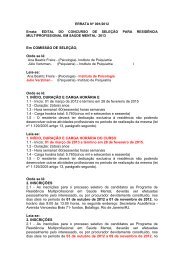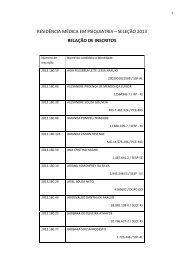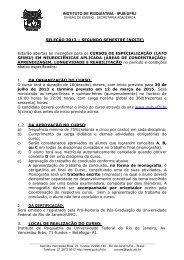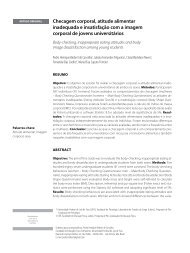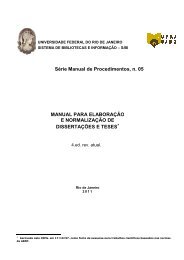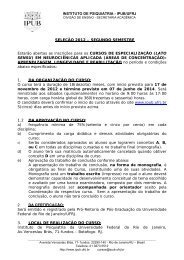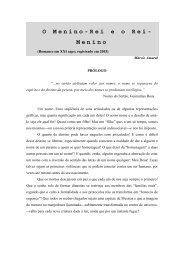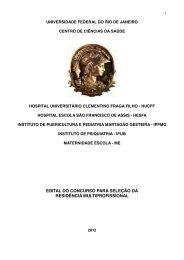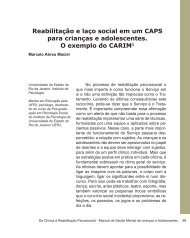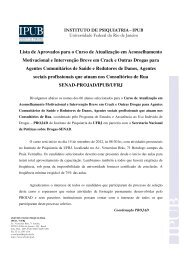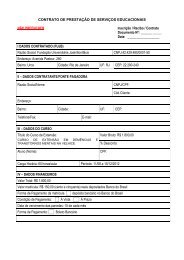Originais â Originals outubro | dezembro ⢠2011 - IPUB - UFRJ
Originais â Originals outubro | dezembro ⢠2011 - IPUB - UFRJ
Originais â Originals outubro | dezembro ⢠2011 - IPUB - UFRJ
You also want an ePaper? Increase the reach of your titles
YUMPU automatically turns print PDFs into web optimized ePapers that Google loves.
ORIGINAL ARTICLE<br />
Panic and cardio-respiratory symptoms<br />
307<br />
This practice allows the patient to find adequate individual<br />
CR, lose the fear of being alone with his or her BS, and<br />
perceive that the physiological reactions that he or she is<br />
having are normal, that they are not originating from something<br />
serious, and that they can be handled by the patient.<br />
It was verified that patients with PD with agoraphobia lost<br />
the fear of natural BS that emerged from physiological alterations<br />
as they were able to perceive, by means of SIE, that the<br />
sensations had a triggering reason and did not arise spontaneously.<br />
Before, the patients usually made erroneous associations<br />
about their BS, interpreting tachycardia, perspiration,<br />
and breathlessness among other symptoms, as signs of<br />
imminent death or loss of control.<br />
According to Barlow 3 , the proposed techniques, IE, and<br />
feared in vivo situations are widely recognised as primary, fundamental,<br />
and efficacious in the reduction of phobic anxiety<br />
reactions. According to Carvalho et al. 2 , the exposure of the<br />
patient to situational generators of anxiety during treatment<br />
should act as a habit-creating process, producing a reduction<br />
of anxiety in the face of stimuli that generate patho logical<br />
anxiety. He 2 verified the efficiency of cognitive interventions,<br />
behavioural interventions, and their combination.<br />
Attention should be given to the improvement of important<br />
methodological aspects in studies that evaluate the<br />
efficiency of CBT, with a view toward obtaining increasingly<br />
true results, thereby indicating which directions that may<br />
contribute to the refining of the techniques used.<br />
In making comparison between the two groups, significant<br />
differences were found in the progress of patients in<br />
the group 1 compared with the control group 2 in the scales:<br />
Sheehan Disability Scale (Total), Sheehan (Work), Sheehan<br />
(Social) and Sheehan (Family). Group 1 showed an improvement<br />
compared to group 2 in all respects. We observed<br />
in group 1 increased motivation to work and to social and<br />
family relationships after 10 sessions of CBT. We believe that<br />
these results were those that involved increased self-esteem<br />
and self-confidence due to the reduction of fears and PA.<br />
Despite the difference found between beginning and<br />
end of treatment period, comparing the two groups was not<br />
statistically significant for the other measurements. Observing<br />
the results of group 1 individually, who received CBT<br />
intervention through the model; we found statistically significant<br />
differences between measurements performed before<br />
and after intervention in most of these parameters, indicating<br />
an improvement in clinical status.<br />
This same improvement cannot be observed in the results<br />
of the control group, considering the same period of<br />
time. Such progress in group 1 should not be discarded,<br />
even by their clinical value.<br />
We therefore suggest that future work on these variables<br />
can be controlled to better understand the effectiveness of<br />
CBT in the context studied. It is necessary to verify if the results<br />
and differences found at the end of the treatment were<br />
actually due to CBT or to the existing variations in the profile<br />
of the group, including, physical or psychiatric comorbidity.<br />
CONCLUSION<br />
The techniques of SIE in the controlled laboratory setting<br />
were essential to reduce and/or remove the hyperventilation<br />
symptoms, tachycardia and changes in breathing as well as<br />
other symptoms. Patients treated with CBT had significant<br />
improvement compared to the group treated with medication.<br />
The techniques of psycho education, CR, IVE and IE, the<br />
PMR exercises and RR exercises were key to the reduction<br />
and management of symptoms in panic disorder.<br />
Our study showed that patients with PD may lower the<br />
PA, hyperventilation and cardio vascular symptoms after the<br />
CBT sessions with SIE.<br />
The main purpose of the study was achieved, which was<br />
to test and observe the efficacy and limitations of the proposed<br />
CBT model in the treatment of PD patients. In spite of<br />
some limitations, the results of this study showed the importance<br />
of CBT and its various techniques, in the treatment of<br />
PD with agoraphobia.<br />
ACKNOWLEDGEMENTS<br />
We would like to express our acknowledgements for the<br />
team of the Panic and Respiration Laboratory (LABPR/<strong>IPUB</strong>/<br />
<strong>UFRJ</strong>, National Institute of Technological Science – Translational<br />
Medicine (INCT-TM) and the National Council for Technological<br />
and Scientific Development (CNPq) for supporting<br />
this research program.<br />
Clinical Trial register number: NCT 00772746.<br />
Committee of Ethics in Research (CEP – <strong>IPUB</strong>/<strong>UFRJ</strong>) Number:<br />
07-06 Approved in 09/03/2006.<br />
Sources of funding: National Council for Scientific and Technological<br />
Development (CNPq).<br />
Conflict of interest: Not declared.<br />
REFERENCES<br />
1. American Psychiatry Association. Diagnostic and Statistical Manual of Mental disorders,<br />
4th ed. American Psychiatry Press, Washington, DC; 1994.<br />
2. Carvalho, MR, Nardi AE, Rangé B. Comparison between cognitive, behavioral and cognitive-<br />
-behavioral approaches in the treatment of panic disorder. Rev Psiq Clín. 2008;35(2);66-73.<br />
3. Barlow DH. Anxiety and its disorders: the nature and treatment of anxiety and panic (Edition).<br />
New York: Guilford Press; 1988.<br />
4. Angelotti G. Terapia cognitivo-comportamental para os transtornos de ansiedade. 1. ed.<br />
São Paulo: Casa do Psicólogo; 2007.<br />
5. King ALS, Valença AM, Nardi AE. Hiperventilação: a terapia cognitivo-comportamental e a<br />
técnica dos exercícios de indução dos sintomas no transtorno de pânico. Rev Port Pneumol.<br />
2008;14(2):303-8.<br />
J Bras Psiquiatr. <strong>2011</strong>;60(4):301-8.




